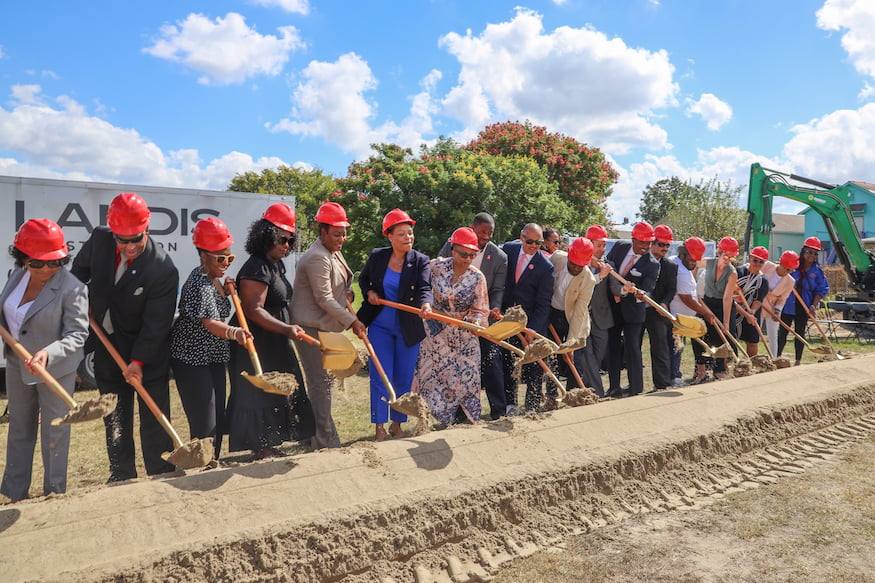Historic Dew Drop Inn Prepares to Reopen Following Million-Dollar Renovation
27th November 2023 ·
By Ryan Whirty
Contributing Writer
The tale is now the stuff of legend. The great Little Richard, who was in New Orleans for a recording session, was frustrating producer Bumps Blackwell, who wasn’t thrilled with the syrupy ballads Richard was offering.
Frustrated, the group of musicians drifted across Lasalle Street to the Dew Drop Inn, one of the most important R&B and jazz clubs in New Orleans, a swinging hotel/bar/nightclub/cafe that hosted the greatest Black musicians of the day.
Richard commandeered a piano at the Dew Drop and began pounding out a raucous, bawdy rave-up that he’d had as part of his live shows for a while. Blackwell and others loved it, and – following some lyrical changes to make it PG-13 – “Tutti Frutti” became one of the greatest songs in rock ’n’ roll history.
A decade and a half later, Richard would cut the song “Dew Drop Inn” for his 1970 album “The Rill Thing” as a tribute to and thank you for the New Orleans club that helped him become one of the creators of rock ’n’ roll:
“Down at the Dew Drop Inn/You meet all your fine friends/ Baby do drop in/I’ll meet you at the Dew Drop Inn.”
There are many stories about the Dew Drop Inn’s glorious heyday as one of the most prestigious and influential loci of Black music for several decades in the mid-20th century. Owned by visionary Big Easy entrepreneur Frank G. Painia, the Dew Drop not only served as a petri dish for classic American music, but it also flouted Louisiana’s Jim Crow segregation laws by brazenly welcoming Black and white patrons, and the inn became a vital part of the New Orleans community, commerce, economy and culture. Numerous civil rights activists also gathered at the hotel and club, where they strategized their efforts to dismantle racial oppression.
After shuttering its doors by the early 1970s, however, the property at 2836 Lasalle Street went through a series of occupants and underwent several changes in uses. But none of those relaunches or renovations could gain any traction, and Dew Drop fell into disrepair before completely shutting down with the destruction wrought by Hurricane Katrina.
But now, thanks to an ambitious, determined investor and new owner, the once-great Dew Drop Inn is on the verge of a remarkable revival that those behind its rising from the ashes hope will harken back to the club and hotel’s chaotic, vibrant and influential glory days.
At the source of the property’s rebirth is New Orleans native and local real-estate developer Curtis Doucette Jr., whose business activity and investments often focus on places with special importance to New Orleans’ Black cultural, social and economic history. That focus spurred him to purchase the Dew Drop property in 2021 and quickly set about renovating and rehabbing the site, with the goal of opening it again as a hotel, music venue, night club and social gathering place that harkens back to the Dew Drop’s peak under Painia.
When completed and opened, the building will offer 17 hotel rooms, including three suites; a restaurant that will serve authentic New Orleans cuisine and could be leased out; a 410-person music venue; and a pool that will be open to the community.
The new edition of the Dew Drop will retain most of the original hotel corridors, balconies and doorways, and the furnishings, artworks and other facets of the facility will harken back to mid-20th-century fashion and design trends. Overall, Doucette and his partners hope to replicate the original Dew Drop as closely as possible while also adding modern touches and amenities.
Doucette said the entire project will cost roughly $11 million, with $6 million of it going to the construction costs. He said financing for the project has come from a variety of resources, including $3.6 million in federal Community Development Block Grant funding, and tax credits for new businesses and historical properties, “and old fashioned equity.”
Doucette said raising money from private and commercial sources was relatively easy because as a project, revitalizing such an important, historic location almost sells itself.
“If you can’t raise money for the Dew Drop Inn, you can’t raise money for anything,” he said. “I’ve never had a project that’s so beloved as this one is.”
He added that when recruiting development partners, investors and other participants for the renovation, he required that each person that was brought about had passion for and pride in the location and its legacy. “You’ve got to have love for the project,” he said. “You’ve got to have reverence for the project and for what it stands for if you want to work on this project.”
Doucette and his partners worked closely with the New Orleans Redevelopment Authority, a public agency created by the state in 1968 as a vehicle for the revitalization of underinvested locations throughout the city.
Brenda M. Breaux, NORA executive director, said her organization is providing $900,000 in permanent debt financing for the Dew Drop site at a substantially-below-market interest rate. NORA expanded its Commercial Corridor Gap Financing Program to include Lasalle Street, a move that will boost redevelopment of properties along that corridor, possibly including the Dew Drop location.
Breaux noted that the Dew Drop “is a site of great importance to the city, state and nation,” adding that “[i]ts contributions to Black history and music are well-documented.” As a result, she said, NORA wanted to play a key role in providing technical assistance and financing for the project, partnering with the state of Louisiana and private financiers.
But, even with the Dew Drop site nearing completion and its grand opening closing in, there’s still much work to be done, Breaux said,
“The historic restoration of this property has eliminated slum and blight conditions and is already contributing to further revitalization and confidence in the Lasalle Street corridor,” she said. “However, NORA recognizes that the restoration of the building alone will not make the project a success. As we approach the grand opening, NORA continues to work with and support the developer to ensure that both the hotel and entertainment businesses are positioned to thrive in the future.”
The architect hired to undertake the planning, design and construction aspects was Studio Kiro, a New Orleans-based firm headed by principal architect Miwako Hattori. Ryan Gootee General Contractors was selected to undertake the construction work, and company Vice President of Communications Kristian Sonnier said his firm was excited to tackle the project.
“This is the kind of stuff we like to do,” Sonnier said at a pre-opening tour event given to local business leaders over the summer. “We do a lot of these types of projects, but when we have the opportunity to preserve the musical culture of the city, we get kind of geeked out,” Sonnier said. “I’m eager to see live music here and eat at the restaurant.”
Doucette said the project’s construction operations have been completed, and all necessary permitting for the revived building and business has been obtained. A date for the club’s grand opening hasn’t been set yet, but Doucette and his partners are aiming for an event in December.
Once open, the new Dew Drop will serve multiple purposes – first, as an active, in-demand hotel, club and pool that caters to all sectors of tourists and locals, and second, as a historical preservation and education center that can act as a cultural repository of days gone by.
In fact, each guest room will be named after one of the music and cultural legends who stayed at or performed in the original Dew Drop Inn, with each room having vintage displays, memorabilia and treasures honoring that particular artist.
“A big part of what we intend to do is make part of it a museum of the different artists who came through here,” Doucette said.
Local civic leaders are equally excited about the revival of the Dew Drop Inn and what it could mean to the community.
“The historic Dew Drop Inn was essential to the cultural fabric of New Orleans, with iconic Black musicians such as Ray Charles, Little Richard and Fats Domino performing in its renowned music venue,” said District B City Councilwoman Lesli Harris. “The revitalization of this gem in District B (specifically Central City) will benefit residents, tourists and inspire local musicians as they continue the time-honored, musical and artistic traditions for generations to come.”
Doucette said one of his biggest goals with the project is making the Dew Drop a beloved and vital part of the local community once again.
“I certainly hope the community will embrace it like it’s theirs,” Doucette said. “There are a lot of people who have a deep ownership of the Dew Drop. There’s a sense of pride with it.”
This article originally published in the November 27, 2023 print edition of The Louisiana Weekly newspaper.


